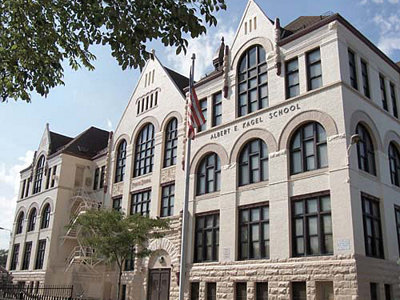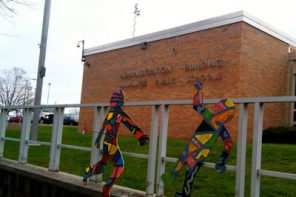Last week, I wrote about Garfield Avenue School, a lovely Romanesque Revival schoolhouse near 4th and North, that was designed by Henry C. Koch, who also designed City Hall, The Pfister Hotel, Turner Hall and Golda Meir School.
The photo you see above, is Kagel Elementary, 1210 W. Mineral St., in Walker’s Point. If you compare it to the second photo – of Meir (originally called Fourth Street School – you’ll see so many similarities that it seems safe to say that Koch also designed Kagel (Mineral Street School), which was built in 1891, the year after Fourth Street School was constructed.
Note that both schools have a central section with a trio of large arched windows and five smaller attic windows above and three insets above that.
They are both flanked by symmetrical wings that repeat the three arched windows theme in sections that — like the central area — span the first and second floors. Above, a central arched window in each wing is flanked by sets of double windows.
The central third-floor windows on each wing are topped with a dormer peak with matching decorations.
Both also share rough-hewn stone exposed basement foundations.
Some other schools from this era are of different design but share some similarities. For example, Maryland Avenue, built in 1887 to designs by Koch, shares the same quintuple window set at the attic level.
While that school also has a rough-hewn stone foundation, you’ll notice in the third photo that it is not exposed. You have to enter the building to see it.
But Maryland and Kagel share another connection. Kagel is named for long-time Milwaukee Public Schools principal Albert E. Kagel.
Kagel was the first principal at Maryland Avenue, serving from 1887 – when the main part of the current building was constructed – until 1902.
Kagel was born in Memel, Germany in 1863 and arrived in Milwaukee seven years later. He attended Forest Home Avenue School (then Eleventh Ward School) and after graduating from the Milwaukee State Normal School in 1884 he was hired as a “grade assistant” and in May 1885 was named principal at Fifth District Branch School.
In 1901, he was made an assistant superintendent, a title he held until his death in 1923. He was acting superintendent in 1913-14. Mineral Street School — which until 1912, when most schools got new monikers, was called District School 8-1 — was renamed in his honor in 1926.
Milton C. Potter, who became superintendent in 1914, called Kagel, “A man of inner kindliness, and therefore of simple courage,” wrote William M. Lamers in “Our Roots Grow Deep,” a history of MPS. “A lover of little children, who feared no man, and therefore hated no man.”
Mineral Street School – like many other early extant school buildings – are part of the legacy of superintendent William Anderson, who was top man at MPS from 1883 until 1892.
Among the other buildings constructed during his tenure were Clybourn Street, Dover Street, East High (Lincoln), Eighth Street, Fifth Street, Fourth Street (Golda Meir), Garfield Avenue, Highland Avenue, Hopkins Street, Lee Street, Longfellow (16th Avenue), Madison Street, Maryland Avenue, McKinley, Mound Street, North Pierce Street, Palmer, Park Street, Prairie Street, Third Street (Victor Berger), Trowbridge, 21st Street, Walnut Street and Windlake Avenue.


 i evaluate to yes even if there's no image
i evaluate to yes even if there's no image  i evaluate to yes even if there's no image
i evaluate to yes even if there's no image  i evaluate to yes even if there's no image
i evaluate to yes even if there's no image  i evaluate to yes even if there's no image
i evaluate to yes even if there's no image  i evaluate to yes even if there's no image
i evaluate to yes even if there's no image  i evaluate to yes even if there's no image
i evaluate to yes even if there's no image